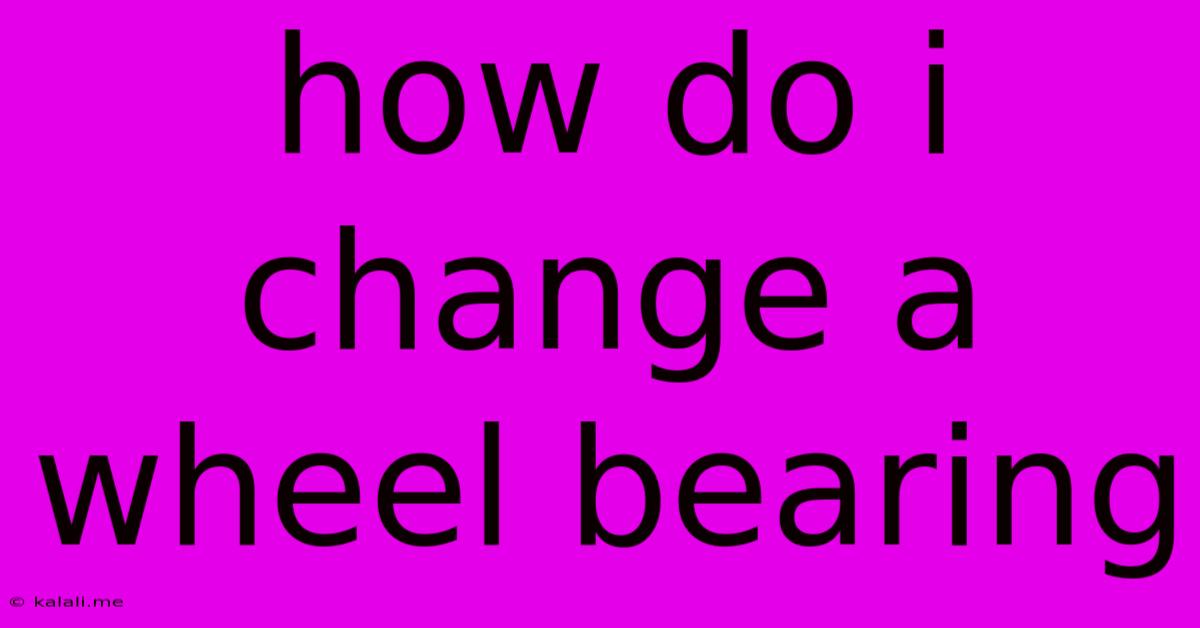How Do I Change A Wheel Bearing
Kalali
May 24, 2025 · 4 min read

Table of Contents
How to Change a Wheel Bearing: A Comprehensive Guide
Changing a wheel bearing might seem daunting, but with the right tools and a methodical approach, it's a manageable DIY project that can save you significant repair costs. This guide will walk you through the process, covering everything from preparation to final checks. This is a complex repair, and if you're uncomfortable with automotive work, it's best to consult a professional mechanic. Incorrectly replacing a wheel bearing can lead to serious safety issues.
Before you begin, gather the necessary tools and parts. You'll need a jack, jack stands (crucial for safety!), wheel chocks, lug wrench, socket wrench set, hammer, punch, pry bar, a new wheel bearing (ensure you get the correct one for your vehicle), grease, and possibly a bearing press (depending on the type of bearing and your vehicle). Consult your vehicle's repair manual for specific torque specifications and part numbers.
Step 1: Preparation and Safety First
- Park on a level surface: Find a safe, level location to work.
- Engage the parking brake: This is vital to prevent the vehicle from rolling.
- Chock the wheels: Place wheel chocks behind the wheels opposite the one you're working on.
- Gather your tools: Make sure you have everything you need before you start.
- Safety glasses and gloves: Protect yourself from potential injury.
Step 2: Removing the Wheel
- Loosen the lug nuts: Use your lug wrench to slightly loosen the lug nuts on the wheel you'll be working on. Do not remove them completely yet.
- Jack up the vehicle: Carefully jack up the vehicle until the wheel is a few inches off the ground.
- Secure with jack stands: Place jack stands securely under the vehicle's frame near the jacking point. Never work under a vehicle supported only by a jack.
- Remove the lug nuts: Now completely remove the lug nuts.
- Remove the wheel: Carefully remove the wheel.
Step 3: Removing the Hub Assembly
This step varies greatly depending on the vehicle make and model. Some vehicles require removing the brake caliper, rotor, and other components before accessing the hub assembly. Consult your vehicle's repair manual for specific instructions. Generally, this may involve:
- Removing the brake caliper: Carefully remove the brake caliper and secure it out of the way using a wire or bungee cord.
- Removing the rotor: Remove the rotor, taking care not to damage the brake pads.
- Removing the cotter pin and castle nut: Locate and carefully remove the cotter pin and castle nut securing the hub assembly.
- Removing the hub assembly: Depending on the design, you may need to use a puller to remove the hub assembly.
Step 4: Removing the Old Wheel Bearing
- Pressing out the bearing: This usually requires a bearing press, although some bearings can be carefully tapped out with a hammer and punch. Be extremely careful not to damage the hub or axle.
- Inspecting the components: Inspect the hub, axle, and other components for damage. Replace any worn or damaged parts.
Step 5: Installing the New Wheel Bearing
- Pressing in the new bearing: Use a bearing press to carefully press the new bearing into the hub. Ensure it's seated properly and flush.
- Packing with grease: Pack the new bearing liberally with grease.
Step 6: Reassembly
This process is the reverse of disassembly. Remember to:
- Tighten the castle nut to the correct torque specification (check your manual).
- Install the cotter pin.
- Reinstall the rotor and brake caliper.
- Reinstall the wheel and tighten the lug nuts to the correct torque specification.
- Lower the vehicle and check for proper wheel rotation and any unusual noises.
Step 7: Final Checks
- Test drive: After reassembly, take the vehicle for a short test drive to check for any vibrations, noises, or unusual handling.
- Re-torque the lug nuts: After the test drive, re-torque the lug nuts to ensure they are properly tightened.
Replacing a wheel bearing is a significant undertaking. This guide provides a general overview; always consult your vehicle's repair manual for detailed, model-specific instructions. If you're unsure about any step, seek professional help. Safety should always be your top priority when performing automotive repairs.
Latest Posts
Latest Posts
-
Starcraft 2 Make An Arcade Game
May 24, 2025
-
Why Does My Toilet Seat Keep Coming Loose
May 24, 2025
-
How Many Screws In A 5 Pound Box
May 24, 2025
-
What Is Raise Me Up About
May 24, 2025
-
How To Fix Seat Belt Warning Light
May 24, 2025
Related Post
Thank you for visiting our website which covers about How Do I Change A Wheel Bearing . We hope the information provided has been useful to you. Feel free to contact us if you have any questions or need further assistance. See you next time and don't miss to bookmark.